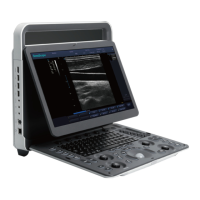1 Safety
4 Basic User Manual
●
Accessory equipment connected to the analog and digital interfaces must be certified
according to the respective EN/IEC standards (for example, EN/IEC 60950 for data
processing equipment and EN/IEC 60601-1 for medical equipment). Furthermore, all
configurations shall comply with the system standards EN/IEC 60601-1.
●
Do not use an endocavitary probe on the body surface of a patient. Otherwise, the
electromagnetic compatibility of the probe may be degraded.
●
If the non-medical electrical equipment used with the system is supplied by a multiple
socket-outlet with separating transformer, connect the AC power plug of the multiple
socket-outlet to a hospital-grade power outlet. Consult a professional to ensure that
the connection complies with the safety standards.
1.2.2 Mechanical Safety
●
To avoid possible personnel injury and system damage, move the system slowly and
carefully.
●
Do not place other objects on top of the control panel. Do not sit on the control panel
or any other part of the system.
●
Disconnect the foot switch and the power cable before moving the system.
●
Do not knock or shake the system.
●
Always use the handle to move the system.
1.2.3 Accessories Caring
Do not use the foot switch in the operating room.
●
Use the probe carefully. If any part of the transducer surface is scratched, stop using the
probe immediately. Otherwise, electrical shock may occur.
●
After disinfecting the accessories, wash out chemicals or discharge gases thoroughly
from the accessories. Residual chemicals or gases could result in damage to the
accessories, and be harmful to human bodies.
●
Only trained physicians or sonographers under ultrasound guidance can handle the
biopsy needle guides. During the operation, the operator must observe proper needle
insertion sequencing with the needle guide to avoid undue discomforts, unnecessary
risks or injuries to the patient.
●
Use the legally marketed probe sheath. Refer to package labeling to determine latex
content. Natural rubber latex may cause anaphylactic reactions in some individuals.
Avoid contact with items containing natural rubber latex. Refer to the FDA Medical
Alert, March 29, 1991.

